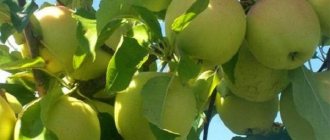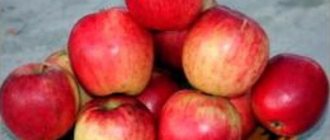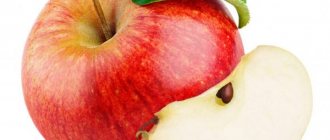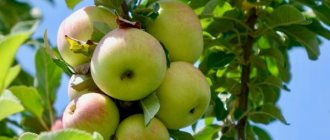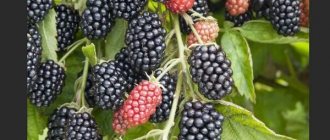The apple tree is a fruit crop that is popular and widely known throughout our country and abroad.
Apple trees look amazingly beautiful during the flowering period, and its fruits have a wonderful taste and are rich in vitamins.
The fruits are stored fresh and processed, allowing a person to receive useful substances throughout the calendar year.
Some varieties of apple trees still grow wild, and there are a huge number of cultivated varieties, so if you decide to take up gardening, namely planting apple trees, you should carefully prepare for this event .
It is necessary to study the relevant literature, select:
- Apple tree variety according to growing conditions and desired result;
- Prepare a place for planting;
- Find a seller of seedlings.
Without working through all of the above measures, you can make mistakes that will negatively affect the development of trees or even lead to their death.
Among the variety of existing varieties of apple trees, the Welsey variety is distinguished by its resistance to disease and cold . Let's take a closer look at this variety.
Description of the variety
The Welsey apple tree variety was zoned in Russia in the 19th century, and then underwent numerous studies in scientific institutions and breeding centers.
After which it became widespread in the center and north-west of our country, as well as in Belarus, Ukraine and European countries.
Variety:
- Moderately winter-hardy,
- Skoroplodny,
- High yielding,
- It is resistant to scab.
The tree is low, medium in size, the crown is broadly pyramidal in shape in the first years of development, then rounded.
The branches grow upward and droop at the ends.
Type of fruiting – mixed. The leaves are small in size, dark green in color, the edges are wavy, crenate, and leathery to the touch.
The flowers of the Welsey apple tree are pink-white in color and medium in size.
Apple tree in bloom.
This variety belongs to the group of early-fruiting varieties , since fruiting occurs in the 4-5th year of tree development.
Apple trees are grown in different regions, so the fruits ripen at different times, from September to October.
The apples are small in size , shaped like a turnip, and smooth. The fruits are picked from the branch when they are yellow-green and consumed when they turn golden.
The color of the fruit cover is dark red in the form of stripes on the main or reddish background. The skin is relatively thin, but at the same time dense, the flesh inside is white, maybe with red streaks.
Evaluate not only the description, the photo will give a visual representation:
Apples have a sweet and sour taste with an amazing aroma .
Advice! The fruits are consumed fresh, and they are also used to prepare juices, compotes, and soaked in their own juice.
Advantages and disadvantages
The positive qualities of this variety include the following:
- High quantitative yield indicators;
- Bright taste;
- Transportability and long shelf life of fruits;
- Having immunity to scab.
Negative points:
- The fruits sometimes fall off during ripening;
- Insufficient winter hardiness when grown in northern latitudes;
- During the period of a large harvest, the fruits decrease in size;
- The taste of the fruit directly depends on climatic conditions.
Apple tree variety Welsey.
Diseases and pests
The Welsey variety has a stable immunity to scab, which destroys a large amount of the crop. But there are other diseases from which the apple tree will need protection. Although the diseases do not affect much, you should pay attention to treatment methods:
- White leaf pubescence may be evidence of powdery mildew. The leaves gradually darken and dry out, and the infection spreads to the fruits. For treatment, you need to use Strobi or Topaz and spray the tree;
- fruits rotting on the tree, which appear due to fruit rot, appear quite rarely on Welsey. But if infected, it is necessary to use Skor or Fundazol;
- bark covered with small red tubercles is a sign of cytosporosis. At the first symptoms, you will need to cut off the damaged part and disinfect the trunk with copper sulfate.
All chemicals to protect against diseases must be used in accordance with the instructions and only before the fruit begins to ripen.
Manifestation of the disease cytosporosis on the trunk of an apple tree.
Some apple tree pests can cause significant harm to the tree. Among them:
- flower beetle - a small beetle that feasts on the sweet insides of flower buds;
- green aphids, which land on young shoots and feed on their juice;
- a codling moth butterfly that eats a delicious fruit from the inside.
There are many mechanical ways to control the population of these pests. They are often collected by hand or installed with bait and fishing belts.
If the degree of damage is great and manual destruction will not help, then you can use folk remedies. Fortunately, there are enough of them, they have been tested over the years and have confirmed their effectiveness.
Chemicals act quickly and effectively. However, they negatively affect beneficial insects and accumulate in fruits.
additional characteristics
Tree height
As previously indicated, the Welsey apple tree is a short tree that belongs to the group of medium-sized ones, and, as a rule, by the period of abundant fruiting the tree grows 2.0 - 4.0 meters in height.
Crown width
If we talk about the period when the tree begins to bear fruit abundantly, then by this moment the crown of the apple tree is 1.5 - 2.0 meters.
Productivity
Welsey is a high-yielding variety . The highest recorded result was 275.0 kg, but, as a rule, up to 200.0 kg can be collected from one tree.
The fruits weigh 80 - 150 g.
Self-fertility
This is an important factor influencing the quality and quantity of the crop.
Fruit and berry plants that are self-fertile do not depend on weather conditions , which affect the behavior of insects (bees, bumblebees, etc.) that pollinate flowers in cross-pollinated plants.
Tasting assessment
Apples have good taste; they have a sweet and sour taste and a delicate aroma. Exact money figures. We didn't find any ratings.
The fruits contain:
- Sahara,
- titratable acids,
- P-active and pectin substances,
- Ascorbic acid.
Winter hardiness
This is a medium-winter-hardy variety that can tolerate drops in ambient temperatures down to – 25 * C , but at lower temperatures, damage to the shoots is possible. So we can assume that the Welsey winter apple tree can be grown in most regions of Russia.
Disease resistance
This variety is immune to the main disease of all fruit trees, which can be considered scab, but, nevertheless, other diseases can affect this apple tree.
Such diseases include the following:
- Fruit rot;
- Powdery mildew;
- Cytosporosis.
Attention! The pests that attack this variety of apple trees are hawthorn and codling moth.
Fruits of the Welsey apple tree.
What to do if the apple tree does not bloom or bear fruit?
A healthy-looking crop may not form flowers or bear fruit for the following reasons:
- The plant is still too young.
- Improper pruning, during which fruit buds are removed.
- The seedling was planted incorrectly: in the shade, close to groundwater, in a draft, so it is not comfortable.
- There is no pollination, you forgot to plant experimental plants.
- The plant is attacked by a flower beetle.
- Iron deficiency in the soil.
Analyze the growing conditions: what conditions are needed for full development, and what conditions you provided. Avoid nitrogen-containing fertilizers for plants older than 2 years, namely, do not feed the trees with compost, manure, or even mulch with grass and tops. It is better to replace it with phosphorus and potassium fertilizers.
Next, you should stop pruning for a couple of years to allow shoots with fruit buds to form. Carefully inspect the plant for pests. Hang the catch belts. Finally, spray with copper sulfate in the spring to compensate for the lack of iron in the soil.
Reviews
Due to the fact that this variety has been widely used in different countries , there are a large number of reviews about its cultivation.
Here are some of them:
Grigory (Ukraine) , writes on the gardening forum: “I really love apples!!! But my favorite ones are “Welsie”!!! They are very beautiful, tasty (sweet and sour), juicy!!! You can make compotes, jams, juices, purees from them (I make “sissy”).
Nezhenka is a very tasty puree with condensed milk, very similar to baby puree (Agusha or Fruto-nanny)!!! If anyone needs a recipe, write in the comments or PM!!! Moreover, apples are very beneficial for our body due to their high vitamin content! By the way, you can also make ice cubes from apple juice and water, which you can use to wipe your face in the morning!!! It improves complexion and makes skin smoother!!! I hope that my review will be useful to someone! Thank you for your attention."
Elena (Moscow region): “Good day everyone! By all appearances, it was an apple year, and last year almost everyone’s apple trees were “resting,” even without flowering. And this year we don’t know who else to share apples with! Now our favorite variety is “Welsie”!!! The apples are huge, even, the taste is sweet and sour, you can feel some kind of pineapple note. I don’t use apples like this for juice - it’s a shame, they last a long time. I’m glad I studied the photo and description of the variety and then purchased it.”
Alexander (Voronezh region): “I have several apple trees of different varieties at my dacha. Everyone has been having great babies for the last few years. Wellsie is the best one to give birth. This year in the fall I also expect a rather large harvest, many small fruits are already hanging.”
Tatyana (Tula): “This is my husband’s favorite apple! Very beautiful, red, tasty. The main thing is that it fits well. We have several apple trees growing. I was on vacation this year.”
Agricultural technology
Apple Tree Dessert Isaeva
Spring is the best period for planting Welsey. And this must be done before the buds open. Choose a place for the apple tree that is level, where water does not stagnate. Groundwater should pass at a depth of 2 m from the surface of the earth.
The apple tree prefers floodplain soil, black soil. It will also take root in gray forest soil.
Before planting a seedling, the ground must be fertilized with humus (5-6 kg per hole), wood ash or manure. Usually the hole is dug a week before planting. A depth of 60-65 cm and a width of 80 cm is sufficient. Then everything is done in the standard way: the seedling is placed on a nutrient mixture, pre-moistened (2-3 buckets of water), the roots are straightened and sprinkled with earth. After this, watering is carried out again and the soil is compacted. The main thing is to prevent voids from appearing among the roots. In this case, mulching with humus will help. After planting, be sure to provide support for the tree.
Mulching
Subsequent care for the Welsey apple tree consists of eliminating weeds near the trunk, mulching, loosening the soil, watering, fertilizing and pruning. You need to loosen the soil every 25-30 days. Watering is carried out in dry weather, when the shoots are gaining strength and actively growing, during the periods of flowering and fruit set. It is better to apply fertilizers in the spring. Nitroammophoska (1 tablespoon for each apple tree) is suitable for this period, and with the beginning of flowering - potassium salt and superphosphate (15-20 g of each). In the fall, sprinkle the tree trunk area with wood ash (500 g for each tree). Organic fertilizers are used every few years.
Raw sunflower seeds: benefits and harms for women
When the Wales apple tree begins to bear fruit, the main thing is not to miss the moment, as the ripe apples begin to crumble. Care must be taken when removing fruits, since broken fruits do not last long in storage.
For your information! An adult apple tree can produce up to 200 kg of apples per season, but if the year was extremely rich in harvest, then next season Welsey will rest and gain strength.
Features of cultivation and care
Landing
Deadlines
Apple trees are planted:
- In the spring,
- In autumn.
In areas with deep groundwater, in prepared pits:
- 70-80 cm deep,
- 1.0 meters in diameter.
Technology
Welsey prefers well-lit places without drafts . The best soils are loamy or loamy-sandy.
Features of cultivation
planting is unacceptable for the root collar, which must remain at a distance of 5.0 - 7.0 cm from the soil surface.
Agricultural technology
The apple tree is demanding when it comes to watering , but it all depends on the weather: in the absence of rain, it is recommended to water once every ten days.
Another activity that must be performed regularly is loosening the soil in the tree trunk circle.
Pruning and crown formation
Apple tree pruning.
Pruning is an important procedure that must be performed annually .
Rejuvenating pruning helps maintain high productivity of the apple tree, and thinning and shortening the branches will avoid their breaking during a bountiful harvest.
Top dressing
The following can be used as fertilizer:
- Manure in proportion to water 1:10;
- Bird droppings in a ratio of 1:15;
- Solutions of wood ash and microelements.
Advice! It is necessary to fertilize several times a year.
What varieties can be grafted onto?
The Welsey variety can be grafted onto the following varieties:
- Candy,
- Seedlings of Ranetka purpurea,
- Clonal rootstocks of the following forms: 54-118,
- 57-400,
- B96,
- 57– 545,
- 5-25-3,
- PK-14,
- 57–66,
- 62-396,
- 57-476
- and others.
Pollinator varieties
as pollinator apple trees :
- Mac,
- Antonovka,
- Borovinka,
- Delicious.
Aftercare for the apple tree
In order for the tree to continue to remain healthy and produce a rich harvest, certain rules for caring for it should be followed:
- The apple tree needs regular moisture. If it doesn’t rain, then the plant needs to be watered every 10 days.
- Another procedure that the Welsey variety requires is loosening the soil around the trunk.
- Every year, fruit tree branches need to be pruned to maintain high yields and prevent breakage due to heavy fruits.
- The plant also needs regular feeding. The Welsey apple tree should be fertilized with substances such as manure, bird droppings or a solution of wood ash with microelements.
Attention! Fertilizers need to be applied 3-4 times a year.
Diseases and pests, methods of control and prevention
To avoid diseases and pests, it is necessary to promptly treat trees with the following means:
- To combat the codling moth, you need to treat the apple tree with Metadione, Zolon or Tsidial 20-25 days after it blooms. This procedure should be carried out 3 times a season.
- For apple scale insects, the tree is treated with Nitrafen until the first buds appear.
- To prevent the plant from being exposed to the apple blossom beetle, it is necessary to treat it with Votafox and Karbofos when buds begin to form.
Subspecies and options
The Welsey apple tree is the mother variety in breeding work.
These varieties are:
- Prima,
- Bezhin meadow,
- Aelita and others.
Welsey apple trees
When growing new trees, dwarf and semi-dwarf rootstocks are used ; specialized breeding centers, as well as amateur gardeners, are engaged in this work.
Advantages and disadvantages
| Advantages of the Welsey variety | Flaws |
|
|
Growing in regions
In different parts of our country, Welsey apple trees are known under other names ; they are called:
- Tartu rose,
- Fertile,
- Abundant,
- Harvest,
- Tartu rosé.
Thanks to their remarkable properties, apple trees of this variety have become widespread in many regions of Russia , such as:
- Northwestern Federal District (Leningrad, Novgorod, Vologda and other regions);
- Central Federal District (Moscow, Ivanovo, Yaroslavl, Voronezh and other regions);
- North Caucasus Federal District (Stavropol Territory and Autonomous Republics);
- Volga Federal District (Nizhny Novgorod, Saratov, Kirov, Ulyanovsk regions, Tatarstan and other regions).
Attention! There are no particular differences in the methods of growing Welsey apple trees in different regions; the only thing you need to pay attention to is that in more northern regions young trees should be covered in winter in order to avoid damage to the shoots. And, of course, the quality of the soil has a significant impact on the growth of trees and the final result - the harvest.
History of selection and zoning of the variety
There is no clear opinion about the origin of the variety. It is known that it was imported to Russia at the end of the 19th century. According to the originator, “Welsie” was obtained as a seedling from free pollination of an unknown variety in 1860 in Minnesota (USA) on the garden plot of M. Gideon.
Experts consider the American version of growing a plant from the seeds of the small-fruited crab apple tree “Peter” to be unlikely.
Crabs are hybrids obtained from crossing the Siberian apple tree and its derivatives with cultivated varieties and Chinese
However, information confirming the development of this variety from the seeds of the Siberian cherry apple tree was published on the website of the All-Russian Research Institute for Breeding Fruit Crops. According to Doctor of Agricultural Sciences F.D. Likhonos, “Welsie” is a seedling from free pollination of the ancient variety of folk selection “Borovinka”.
Since the late 40s of the last century, the variety has been under state testing, studied at the Oryol fruit and berry point, the Shushensky state variety site of the Krasnoyarsk Territory, in the Voronezh pomological nursery and other stations. In 1947, it was officially included in the State Register of the Russian Federation as zoned and recommended for commercial and amateur gardening in six regions. Also, this apple tree is well adapted to the conditions of Ukraine, Belarus, the Baltic states and other neighboring countries.
The variety has several names: Welthy, “Abundant”, “Urozhaynoe”, “Fertile”, “Tartu Rose”, “Tartu Rose”, under which various nurseries offer it.
Landing rules
Depending on the characteristics of the site, when planting Wales, 10 rules are taken into account that will become useful. If you take into account the accompanying nuances, the apple tree will give the maximum yield:
- groundwater must be at a depth of at least 2.5 meters. Otherwise, the plant simply will not be able to grow fully, and may even dry out.
- Planting is done in early spring or late autumn .
- It is better to place the tree in a part of the site where there is no exposure to direct sunlight .
- It is important to place additional pollinators next to this type of fruit , namely other varieties of apple trees.
- The soil needs to be loosened and breathable , so clay soil is not suitable for planting purposes.
- The soil requires adjustment, namely the application of fertilizers and minerals .
- The hole is formed according to the size of the seedling's rhizome.
- A fertile layer of soil is laid in the center of the excavation .
- After this, we fill the seedling with a surface layer of soil.
- The earth is compacted tightly around a thin trunk, and then filled with water: 1-2 buckets.
- To prevent the plant from swaying, the trunk or branches are fixed to a peg .
Welsey seedling planting scheme
If you follow all the above rules, the harvest will remain large and of high quality from year to year. The tree itself in this case will not require special care.
Transplanting raspberries - choosing the best season
Buds and shoots
The buds are distinctly convex and large in size; they are often lowered. Lentils are round in shape and there are a lot of them on the tree. The shoots of the apple tree are medium-low, distinguished by their brown color and the average thickness of the branches. The tree does not grow quickly. The size of the leaves is small, sometimes medium, the tops of the leaves are curled. Their color is dark green and they shine well in the sun.



